人教版高中英语选修8unit1单词及课文详解
(完整版)选修8UNIT1词汇讲解
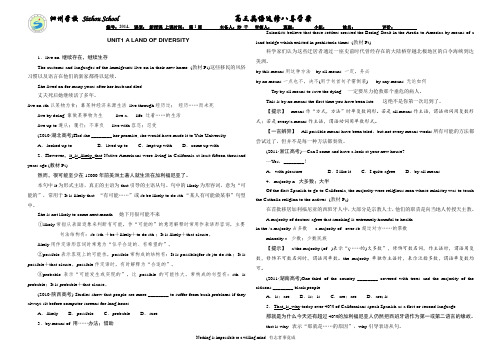
泗州学校Sizhou School高三英语选修八导学案编号:2014- 课型:新授课上课时间:第1周主备人:沙千审核人:班级:小组:姓名:评价:UNIT1 A LAND OF DIVERSITY1.live on 继续存在,继续生存The customs and languages of the immigrants live on in their new home. (教材P1)这些移民的风俗习惯以及语言在他们的新家都得以延续。
She lived on for many years after her husband died.丈夫死后她继续活了多年。
live on sth以某物为食;靠某种经济来源生活live through经历过;经历……而未死live by doing 靠做某事物为生live a... life 过着……的生活live up to遵从;履行;不辜负live with容忍;忍受(2010·湖北高考)Had she ________ her promise, she would have made it to Yale University.A.looked up to B.lived up to C.kept up with D.come up with2.However,it_is_likely_that Native Americans were living in California at least fifteen thousand years ago.(教材P2)然而,很可能至少在15000年前美洲土著人就生活在加利福尼亚了。
本句中it为形式主语,真正的主语为that引导的主语从句。
句中的likely为形容词,意为“可能的”,常用于It is likely that...“有可能……”或sb.be likely to do sth.“某人有可能做某事”句型中。
人教版高中英语选修8unit1单词及课文详解
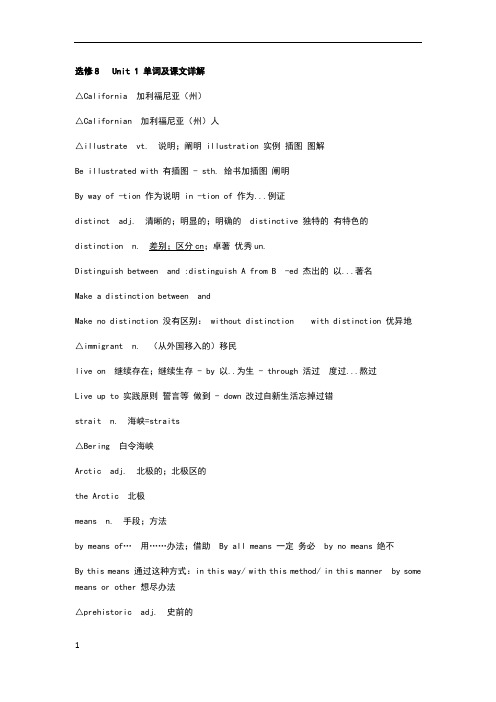
选修8 Unit 1 单词及课文详解△California 加利福尼亚(州)△Californian 加利福尼亚(州)人△illustrate vt. 说明;阐明 illustration 实例插图图解Be illustrated with 有插图 - sth. 给书加插图阐明By way of -tion 作为说明 in -tion of 作为...例证distinct adj. 清晰的;明显的;明确的 distinctive 独特的有特色的distinction n. 差别;区分cn;卓著优秀un.Distinguish between and :distinguish A from B -ed 杰出的以...著名Make a distinction between andMake no distinction 没有区别: without distinction with distinction 优异地△immigrant n. (从外国移入的)移民live on 继续存在;继续生存 - by 以..为生 - through 活过度过...熬过Live up to 实践原则誓言等做到 - down 改过自新生活忘掉过错strait n. 海峡=straits△Bering 白令海峡Arctic adj. 北极的;北极区的the Arctic 北极means n. 手段;方法by means of… 用……办法;借助 By all means 一定务必 by no means 绝不By this means 通过这种方式:in this way/ with this method/ in this manner by some means or other 想尽办法△prehistoric adj. 史前的majority n. 大多数;大半 the - 做主语谓语动词单数各个成员可用复数The - of + 单数名词或pl. 谓语动词与名词保持一致In a - 占大多数 get a - 获得多数票 have a - 拥有多数Major minor minority -ity ...状态、性质ministry n. (政府的)部;(全体)牧师;牧师的职责神职任期 the - of Defense Catholic adj. 天主教的 n.天主教徒△Alaska n. 阿拉斯加(州)△San Francisco n. 圣弗朗西斯科(也称旧金山)△adventurer n. 冒险家make a life 习惯于新的生活方式、工作等△despite prep. 尽管;不管hardship n. 苦难;困苦elect vt. 选择;决定做某事;选举某人federal adj. 联邦制的;联邦政府的rail n. 铁路;扶手;(护栏的)横条percentage n. 百分比;百分率△Los Angeles n. 洛杉矶Italy n. 意大利Italian n. 意大利人;意大利语adj.意大利人的;意大利语的Denmark n. 丹麦(北欧国家)keep up 坚持;维持;沿袭(风俗、传统等)- away from 不接近- back 阻止抑制 -... From 阻止免受伤害 - off 远离 - out 使不入内- up with 跟上 -an eye on 注视 - hold of 抓住 - a record of记载 - in touch with△Hollywood n. 好莱坞;美国电影业boom n. (人口、贸易的)繁荣(运动音乐)突然风靡的时期深沉的响声V. 轰鸣激增处于经济迅速发展时期-er=baby -er 生育高峰期出生的人 - town 新兴都市aircraft n. 飞行器;航空器;飞机△Cambodian n. 柬埔寨人;柬埔寨语Korea n. 韩国;朝鲜Korean n. 韩国/朝鲜人;朝鲜/韩语 adj.韩国(人/语)的;朝鲜(人/语)的Pakistan n. 巴基斯坦Pakistani adj. 巴基斯坦(人)的 n.巴基斯坦人△immigrate vi. 移入(外国定居)immigration n. 移民;移居入境racial adj. 人种的;种族的crossing n. 横渡;横越;十字路口;人行横道vice n. & adj. 代理;副职nephew n. 侄子;外甥pole n. 地极;电极;磁极applicant n. 申请人customs n. 海关;关税;进口税socialist n. 社会主义者;社会党人 adj.社会主义者的socialism n. 社会主义occur vi. 发生;出现有计划或无计划It -s to sb. To do/ that... 某人想到 -rencecattle n. 牛(总称)△Hispanic n. (美)讲西班牙语的美国人indicate vt. 指出;指示;表明;暗示back to back 背靠背luggage n. 行李(<美>baggage)shave vt. & vi. (shaved; shaved, shaven) 刮;剃△cable n. 缆绳;绳索;电缆△cable car 缆车;(美)有轨缆车△Andrew Hallidie 安德鲁•海利迪tram n. (有轨)电车apparent adj. 显而易见的;显然的;表面上的apparently adv. 显然地;显而易见地It is - to sb. That... 在某人看来显然...brake n. 闸;刹车;制动器 Vi. & vt. 刹(车);用制动器减速conductor n. (公车)售票员;列车员;(乐队)指挥slip vi. 滑动;滑行;滑跤 n.滑动;滑倒小错误- off 迅速脱去衣服:- out of -on 迅速穿上 -out 被无意中说出- away 消失消亡 - up 犯错误疏忽△wharf n. 码头bakery n. 面包房;面包厂ferry n. 渡船;渡口 vt.摆渡;渡运△Angel Island 天使岛team up with 与……合作或一起工作hire vt. & n. 租用;雇用- sth. To ...租给 - ... From...向...租借租设备用hire 租房子:let/rent△fascinating adj. 迷人的;吸引人的mark out 划线;标出……界线选定表明- down 记下减价给低分 - off 划出界限 -up 标高价格 - with 以..为标记- for life 留下终生的伤痕seagull n. 海鸥take in 包括;吸收理解欺骗- apart 拆开 -away 拿走 - back 收回- to 喜欢习惯 - on承担呈现雇佣 - over 接管-up 占据继续 -up with 和交往angle n. 角;角度a great/good many 许多;很多Many/many a/an / a great/good many/ more than one/ a good/large number of +pl.Much/ a good/great deal of/ a large amount of /amounts of+unA lot of/lots of/ a quantity of/ quantities of/ plenty of/ a supply of/supplied of+pl./unAmounts of/ quantities of+un. 谓语动词用复数Many a(more than one)+单数谓语动词用单数apply for 申请;请示得到Apply 申请敷产生作用使努力- to do 申请做 - ..to..将...涂抹于- oneself to 专心从事 applicant application appliednowhere adv. 无处;到处都无△miserable adj. 痛苦的;悲惨的punishment n. 处罚;惩罚justice n. 公正;公平mourn vt. & vi. 哀悼;悼念;表示悲痛 -er哀悼者 -ful 忧伤的 -ing n, 哀悼civil adj. 公民的;国内的;民间的authority n. 权威;权力 (pl)当局;官方reform vt. & vi. 改革;革新 n.改革;改造;改良grasp vt. & n. 抓住;抓紧;掌握;领会△thoughtful adj. 关切的;体贴的;深思的thankful adj. 感激的;感谢的insert vt. 插入;嵌入 n. 插面广告挿入物 -ion 放入选修八Unit1 CALIFORNIA加利福尼亚California is the third largest state in the USA but has the largest population (grow/fall; large/small). 加州是美国第三大洲, 而且是人口最多的州。
人教版高中英语选修八 Unit1 A land of diversity-词汇篇(教师版)
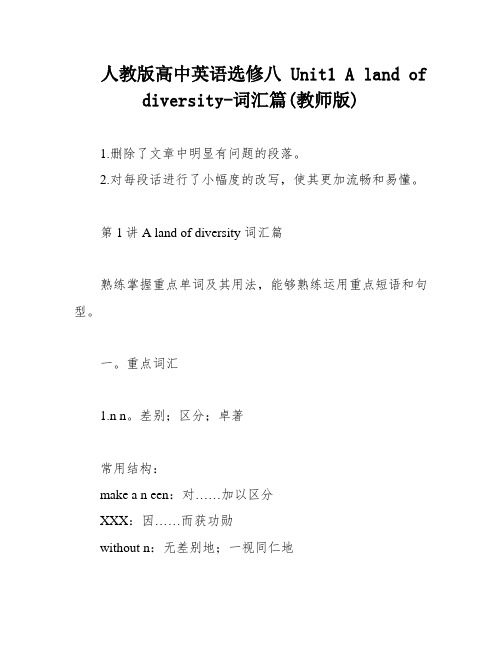
人教版高中英语选修八 Unit1 A land of diversity-词汇篇(教师版)1.删除了文章中明显有问题的段落。
2.对每段话进行了小幅度的改写,使其更加流畅和易懂。
第1讲 A land of diversity 词汇篇熟练掌握重点单词及其用法,能够熟练运用重点短语和句型。
一。
重点词汇1.n n。
差别;区分;卓著常用结构:make a n een:对……加以区分XXX:因……而获功勋without n:无差别地;一视同仁地拓展:distinct adj。
清晰的;明显的;明确的XXX。
在某方面与……不同XXX。
他有很明显的绘画天赋。
You should make your writing distinct。
你应该把字写清楚。
2.means n。
手段;方法(单数和复数形式相同)常用结构:by means of:用……办法;借助……by all means:一定,务必;好的,当然可以by no means:决不,一点也不(位于句首时,句子用部分倒装)by every means:用尽一切可能的办法易混辨析:means/way/methodmeans 指“方法、方式、工具”,着重于具体的手段(单复数形式相同)。
way 指“一般的方法、方式或个人的特殊方法、方式”,与技巧或效果的好坏无关。
method 指“有系统的、有效率的精心拟定的方法”,也可以指抽象概念“条理”。
a way to do sth。
/ a way of doing sth。
/ a method of doing sth。
做……的方法in this way / with the method / by this means:用这种/些方法by XXX:顺便问一下on one’s way to。
在去……的路上in the way:挡住路注意:XXX。
They used white paint to mark out the XXX。
人教版高中英语选修八-unit-1-单词PPT课件
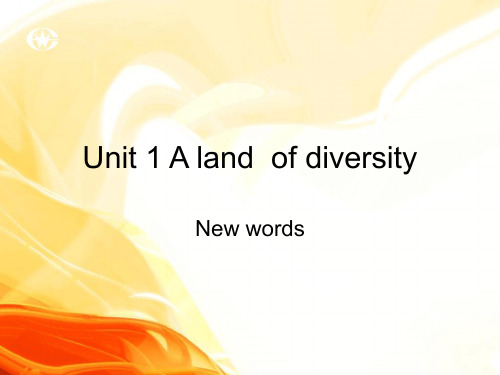
2021/7/22
2
2. despite prep. 尽管;不管
He went to work despite his illness. 尽管生病,他还是去工作
Despite what others say, I think he is a
nice fellow. despite用作介词时,与 in spite of同义,都 表示“尽管”、“虽然”、“不顾”之意.
11. reform n. 1. 改革,改良;改过,自新[C][U]
vt. 改革 The new government made many needed reforms. 新政府进行了许多必要的改革. We must reform the outdated rules and regulations.
heart to heart
shoulder to shoulder
hand in hand
arm in arm
2021/7/22
7
10. apparent adj. ( obvious )
apparently adv.
It is apparent that he is wrong.
Apparently, he is wrong.
In spite of the heavy rain, we arrived at the station on time.
2021/7/22
3
3. percentage n. 百分比;百分率 1.百分比, 百分率 Television attracts a large percentage of the people. 电视吸引了大部分观众。 2.比例 What is the percentage of oxygen in air? 空气中所含的氧的比例是多少? percent 百分数 Forty percent of the students are for the plan.
(完整版)选修8UNIT1词汇讲解

泗州学校Sizhou School高三英语选修八导学案编号:2014- 课型:新授课上课时间:第1周主备人:沙千审核人:班级:小组:姓名:评价:UNIT1 A LAND OF DIVERSITY1.live on 继续存在,继续生存The customs and languages of the immigrants live on in their new home. (教材P1)这些移民的风俗习惯以及语言在他们的新家都得以延续。
She lived on for many years after her husband died.丈夫死后她继续活了多年。
live on sth以某物为食;靠某种经济来源生活live through经历过;经历……而未死live by doing 靠做某事物为生live a... life 过着……的生活live up to遵从;履行;不辜负live with容忍;忍受(2010·湖北高考)Had she ________ her promise, she would have made it to Yale University.A.looked up to B.lived up to C.kept up with D.come up with2.However,it_is_likely_that Native Americans were living in California at least fifteen thousand years ago.(教材P2)然而,很可能至少在15000年前美洲土著人就生活在加利福尼亚了。
本句中it为形式主语,真正的主语为that引导的主语从句。
句中的likely为形容词,意为“可能的”,常用于It is likely that...“有可能……”或sb.be likely to do sth.“某人有可能做某事”句型中。
人教版高中英语选修8U1知识详解
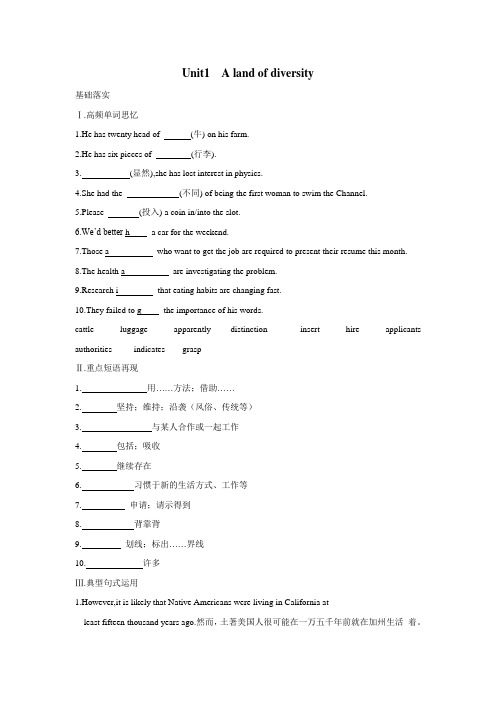
Unit1 A land of diversity基础落实Ⅰ.高频单词思忆1.He has twenty head of (牛) on his farm.2.He has six pieces of (行李).3. (显然),she has lost interest in physics.4.She had the (不同) of being the first woman to swim the Channel.5.Please (投入) a coin in/into the slot.6.We’d better h a car for the weekend.7.Those a who want to get the job are required to present their resume this month.8.The health a are investigating the problem.9.Research i that eating habits are changing fast.10.They failed to g the importance of his words.cattle luggage apparently distinction insert hire applicants authorities indicates graspⅡ.重点短语再现1. 用……方法;借助……2. 坚持;维持;沿袭(风俗、传统等)3. 与某人合作或一起工作4. 包括;吸收5. 继续存在6. 习惯于新的生活方式、工作等7. 申请;请示得到8. 背靠背9. 划线;标出……界线10. 许多Ⅲ.典型句式运用1.However,it is likely that Native Americans were living in California atleast fifteen thousand years ago.然而,土著美国人很可能在一万五千年前就在加州生活着。
高中英语 人教版新课标选修八unit1 a land of diversity重点单词讲解 35张ppt

2
1
distinction/dɪ'stɪŋkʃən/ n. 差别,区分,卓著
• = di-分离 + -stinct-刺 + -ion名词词尾---把刺分开---区分
• extinct (把刺拿出去) adj. 灭绝的
• instinct (内在的刺激) n.本能,本性
• sting n. 刺
2020/5/21
4
occur/ə'kɝ/ vi. 发生,存在,出现
• =oc+curr(流,跑) → 事情跑过来即为“发生”,事情跑入脑中即为“想起”
• concur v. 同意;同时发生
• recur v. 重现,再发生
• incur v. 招致,引发
• It ~ s to sb that...某人想起
2020/5/21
8
hire/employ/rent
• hire短期租佣 • employ 长期雇佣 ~ sb • rent长期租用 ~ sth • I took my driving license with me on holiday, in case I wanted to _____a
car. • The cost of ______ a house in central Xi'an in higher than that in any
• It is ~/obvious/evident that... 很明显...
• be ~ /different from...in... 在...方面与...不同
2020/5/21
2
majority/mə'dʒɔrəti/n. 大半;大多数
人教版高中英语单词表选修八unit 1
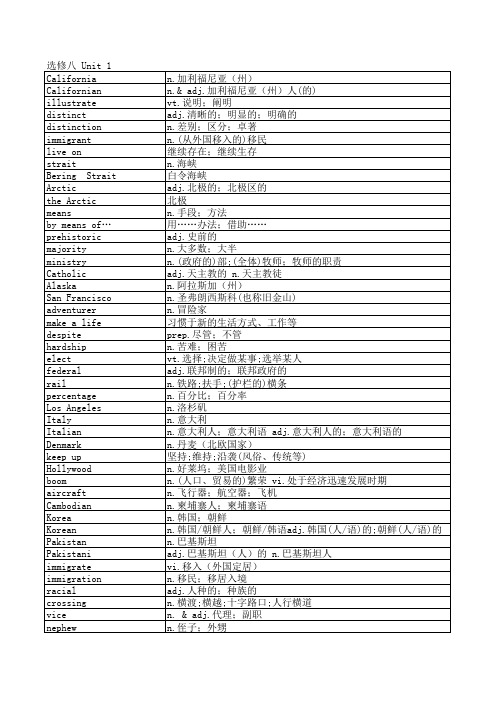
n.加利福尼亚(州) n.& adj.加利福尼亚(州)人(的) vt.说明;阐明 adj.清晰的;明显的;明确的 n.差别;区分;卓著 n.(从外国移入的)移民 继续存在;继续生存 n.海峡 白令海峡 adj.北极的;北极区的 北极 n.手段;方法 用……办法;借助…… adj.史前的 n.大多数;大半 n.(政府的)部;(全体)牧师;牧师的职责 adj.天主教的 n.天主教徒 n.阿拉斯加(州) n.圣弗朗西斯科(也称旧金山) n.冒险家 习惯于新的生活方式、工作等 prep.尽管;不管 n.苦难;困苦 vt.选择;决定做某事;选举某人 adj.联邦制的;联邦政府的 n.铁路;扶手;(护栏的)横条 n.百分比;百分率 n.洛杉矶 n.意大利 n.意大利人;意大利语 adj.意大利人的;意大利语的 n.丹麦(北欧国家) 坚持;维持;沿袭(风俗、传统等) n.好莱坞;美国电影业 n.(人口、贸易的)繁荣 vi.处于经济迅速发展时期 n.飞行器;航空器;飞机 n.柬埔寨人;柬埔寨语 n.韩国;朝鲜 n.韩国/朝鲜人;朝鲜/韩语adj.韩国(人/语)的;朝鲜(人/语)的 n.巴基斯坦 adj.巴基斯坦(人)的 n.巴基斯坦人 vi.移入(外国定居) n.移民;移居入境 adj.人种的;种族的 n.横渡;横越;十字路口;人行横道 n. & adj.代理;副职 n.侄子;外甥
高中英语选修8 unit1-词汇讲解

在中国,北方人以玉米和小麦为主食,而南方人以大米为主食。
⑵ The operation was very successful, and the old man lived on for another ten years.
be taken in… 上当;受骗 判断下列句子中take in的意思
1. I found it easy to take in what the teacher had taught. ( 理解 )
2. Trees take in carbon dioxide from the air and make oxygen. ( 吸收 )
3. Don’t let yourself be taken in by his tricks. 4. His tour will take in Scotland and London.
( 受骗 ) ( 包括 )
⑵ I want a distinct answer to my question.
对我的问题我要一个明确的答复。
⑶ We must make a distinction between facts and opinions.
我们必须分清事实和观点。
2. live on 1. 继续存在,继续生活 2. 以吃...为食;靠…生活
despite(尽管)是介词,不是连词,所以不能用来引导句子,若 其后要跟 that 从句,需插入 the fact,Despite the fact that…
1. Despite/ in spite of the heavy rain, we arrived at the station on 。
人教版英语选修8课文原文及课文译文
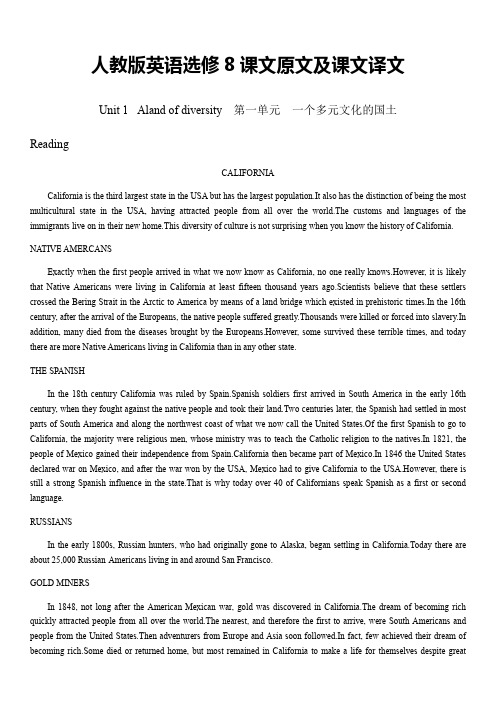
人教版英语选修8课文原文及课文译文Unit1Aland of diversity第一单元一个多元文化的国土ReadingCALIFORNIACalifornia is the third largest state in the USA but has the largest population.It also has the distinction of being the most multicultural state in the USA, having attracted people from all over the world.The customs and languages of the immigrants live on in their new home.This diversity of culture is not surprising when you know the history of California.NA TIVE AMERCANSExactly when the first people arrived in what we now know as California, no one really knows.However, it is likely that Native Americans were living in California at least fifteen thousand years ago.Scientists believe that these settlers crossed the Bering Strait in the Arctic to America by means of a land bridge which existed in prehistoric times.In the 16th century, after the arrival of the Europeans, the native people suffered greatly.Thousands were killed or forced into slavery.In addition, many died from the diseases brought by the Europeans.However, some survived these terrible times, and today there are more Native Americans living in California than in any other state.THE SPANISHIn the 18th century California was ruled by Spain.Spanish soldiers first arrived in South America in the early 16th century, when they fought against the native people and took their land.Two centuries later, the Spanish had settled in most parts of South America and along the northwest coast of what we now call the United States.Of the first Spanish to go to California, the majority were religious men, whose ministry was to teach the Catholic religion to the natives.In 1821, the people of Mexico gained their independence from Spain.California then became part of Mexico.In 1846 the United States declared war on Mexico, and after the war won by the USA, Mexico had to give California to the USA.However, there is still a strong Spanish influence in the state.That is why today over 40 of Californians speak Spanish as a first or second language.RUSSIANSIn the early 1800s, Russian hunters, who had originally gone to Alaska, began settling in California.Today there are about 25,000 Russian-Americans living in and around San Francisco.GOLD MINERSIn 1848, not long after the American-Mexican war, gold was discovered in California.The dream of becoming rich quickly attracted people from all over the world.The nearest, and therefore the first to arrive, were South Americans and people from the United States.Then adventurers from Europe and Asia soon followed.In fact, few achieved their dream of becoming rich.Some died or returned home, but most remained in California to make a life for themselves despite greathardship.They settled in the new towns or on farms.By the time California elected to become the thirty-first federal state of the USA in 1850, it was already a multicultural society.LATER A RRIV ALSAlthough Chinese immigrants began to arrive during the Gold Rush Period, it was the building of the rail network from the west to the east coast that brought even larger numbers to California in the 1860s.Today, Chinese-Americans live in all parts of California, although a large percentage have chosen to stay in the "Chinatowns" of Los Angeles and San Francisco.Other immigrants such as Italians, mainly fishermen but also wine makers, arrived in California in the late 19th century.In 1911 immigrants from Denmark established a town of their own, which today still keeps up their Danish culture.By the 1920s the film industry was well established in Hollywood, California.The industry boom attracted Europeans including many Jewish people.Today California has the second largest Jewish population in the United States.Japanese farmers began arriving in California at the beginning of the 20th century, and since the 1980s a lot more have settled there.People from Africa have been living in California since the 1800s, when they moved north from Mexico.However, even more arrived between 1942 and 1945 to work in the ship and aircraft industries.MOST RECENT ARRIV ALSIn more recent decades, California has become home to more people from Asia, including Koreans, Cambodians, Vietnamese and Laotians.Since its beginning in the 1970s, the computer industry has attracted Indians and Pakistanis to California.THE FUTUREPeople from different parts of the world, attracted by the climate and the lifestyle, still immigrate to California.It is believed that before long the mix of nationalities will be so great that there will be no distinct major racial or cultural groups,but simply a mixture of many races and cultures.加利福尼亚加利福尼亚是美国的第三大州, 而且是人口最多的州。
英语选修8 unit1 词汇汉译英及课文翻译
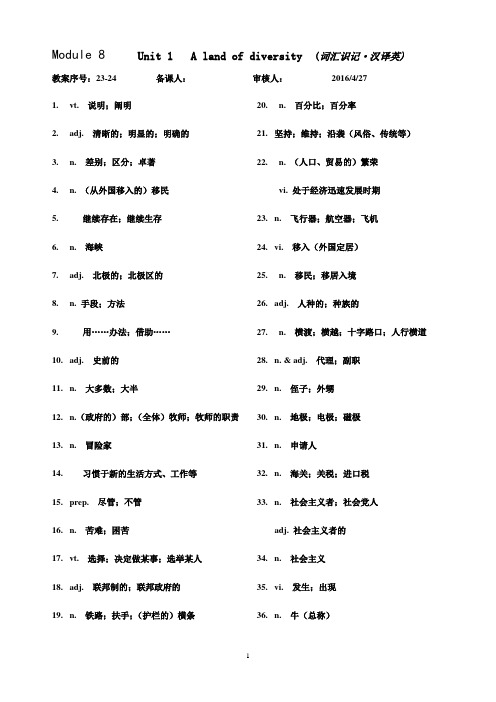
Module 8Unit 1 A land of diversity (词汇识记·汉译英)教案序号:23-24 备课人:审核人:2016/4/271.vt. 说明;阐明2.adj. 清晰的;明显的;明确的3.n. 差别;区分;卓著4.n. (从外国移入的)移民5.继续存在;继续生存6.n. 海峡7.adj. 北极的;北极区的8.n. 手段;方法9.用……办法;借助……10.adj. 史前的11.n. 大多数;大半12.n.(政府的)部;(全体)牧师;牧师的职责13.n. 冒险家14.习惯于新的生活方式、工作等15.prep. 尽管;不管16.n. 苦难;困苦17.vt. 选择;决定做某事;选举某人18.adj. 联邦制的;联邦政府的19.n. 铁路;扶手;(护栏的)横条20.n. 百分比;百分率21.坚持;维持;沿袭(风俗、传统等)22.n. (人口、贸易的)繁荣vi. 处于经济迅速发展时期23.n. 飞行器;航空器;飞机24.vi. 移入(外国定居)25.n. 移民;移居入境26.adj. 人种的;种族的27.n. 横渡;横越;十字路口;人行横道28.n. & adj. 代理;副职29.n. 侄子;外甥30.n. 地极;电极;磁极31.n. 申请人32.n. 海关;关税;进口税33.n. 社会主义者;社会党人adj. 社会主义者的34.n. 社会主义35.vi. 发生;出现36.n. 牛(总称)班级37.vt. 指出;指示;表明;暗示38.背靠背39.n. 行李40.vt. & vi.刮;剃41.n. 缆绳;绳索;电缆42.缆车;(美)有轨缆车43.n. (有轨)电车44.adj. 显而易见的;显然的;表面上的45.adv. 显然地;显而易见地46.n. 闸;刹车;制动器Vi. & vt. 刹(车);用制动器减速47.n. (公车)售票员;列车员;(乐队)指挥48.vi. 滑动;滑行;滑跤n.滑动;滑倒49.n. 码头50.n. 面包房;面包厂51.n. 渡船;渡口vt.摆渡;渡运52.与……合作或一起工作53.vt. & n. 租用;雇用54.adj. 迷人的;吸引人的姓名55.划线;标出……界线56.n. 海鸥57.包括;吸收58.n. 角;角度59.许多;很多60.申请;请示得到61.adv. 无处;到处都无62.adj. 痛苦的;悲惨的63.n. 处罚;惩罚64.n. 公正;公平65.vt. & vi. 哀悼;悼念;表示悲痛66.adj. 公民的;国内的;民间的67.n. 权威;权力(pl)当局;官方68.vt. & vi. 改革;革新n.改革;改造;改良69.vt. & n. 抓住;抓紧;掌握;领会70.adj. 关切的;体贴的;深思的71.adj. 感激的;感谢的72.vt. 插入;嵌入选修8 Unit 1 课文对照翻译Reading Two 乔治的日记6月12日星期一清晨乘公共汽车抵达,直赴饭店,放下行李,洗澡、刮脸,即去观光。
英语选修8 unit1 词汇英译汉及课文翻译

Module 8Unit 1 A land of diversity (词汇识记·英译汉)教案序号:21-22 备课人:审核人:2016/4/221.illustrate vt.2.distinct adj.3.distinction n.4.immigrant n.5.live on6.strait n.7.Arctic adj.8.means n.9.by means of…10.prehistoric adj.11.majority n.12.ministry n.13.adventurer n.14.make a life15.despite prep.16.hardship n.17.elect vt.18.federal adj.19.rail n.20.percentage n.21.keep up22.boom n.. vi.23.aircraft n.24.immigrate vi.25.immigration n.26.racial adj.27.crossing n.28.vice n. & adj.29.nephew n.30.pole n.31.applicant n.32.customs n.33.socialist n. adj.34.socialism n.35.occur vi.36.cattle n. 37.indicate vt.38.back to back39.luggage n.40.shave vt. & vi.41.cable n.42.cable car43.tram n.44.apparent adj.45.apparently adv.46.brake n. Vi. & vt.47.conductor n.48.slip vi. n.49.wharf n.50.bakery n.51.ferry n. vt.52.team up with53.hire vt. & n.54.fascinating adj.55.mark out56.seagull n.57.take in58.angle n.59.a great/good many60.apply for61.nowhere adv.62.miserable adj.63.punishment n.64.justice n.65.mourn vt. & vi.66.civil adj.67.authority n.68.reform vt. & vi. n.69.grasp vt. & n.70.thoughtful adj.71.thankful adj.72.insert vt.班级姓名选修8 Unit 1 课文对照翻译Reading One 加利福尼亚加州是美国第三大州,而且是人口最多的州。
人教高中英语选修八全册重点单词解析unit1unit2unit3unit4unit5
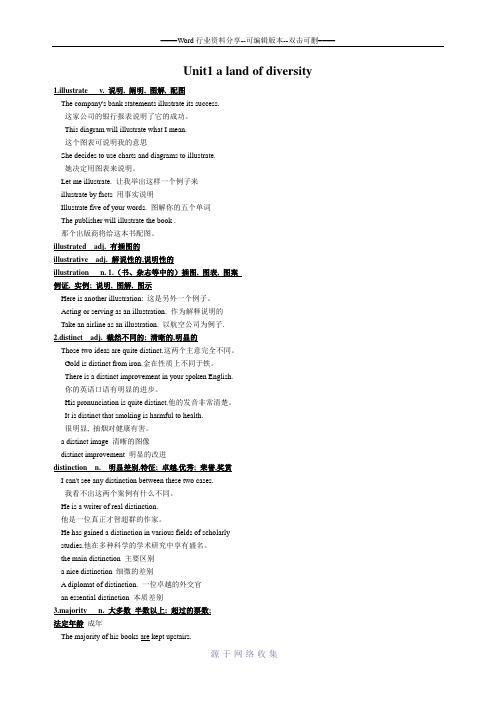
Unit1 a land of diversity 1.illustrate v. 说明, 阐明, 图解, 配图The company's bank statements illustrate its success.这家公司的银行报表说明了它的成功。
This diagram will illustrate what I mean.这个图表可说明我的意思She decides to use charts and diagrams to illustrate.她决定用图表来说明。
Let me illustrate. 让我举出这样一个例子来illustrate by facts 用事实说明Illustrate five of your words. 图解你的五个单词The publisher will illustrate the book .那个出版商将给这本书配图。
illustrated adj. 有插图的illustrative adj. 解说性的,说明性的illustration n. 1.(书、杂志等中的)插图, 图表, 图案例证, 实例; 说明, 图解, 图示Here is another illustration: 这是另外一个例子。
Acting or serving as an illustration. 作为解释说明的Take an airline as an illustration. 以航空公司为例子.2.distinct adj. 截然不同的; 清晰的,明显的Those two ideas are quite distinct.这两个主意完全不同。
Gold is distinct from iron.金在性质上不同于铁。
There is a distinct improvement in your spoken English.你的英语口语有明显的进步。
His pronunciation is quite distinct.他的发音非常清楚。
高中英语选修八课文及翻译
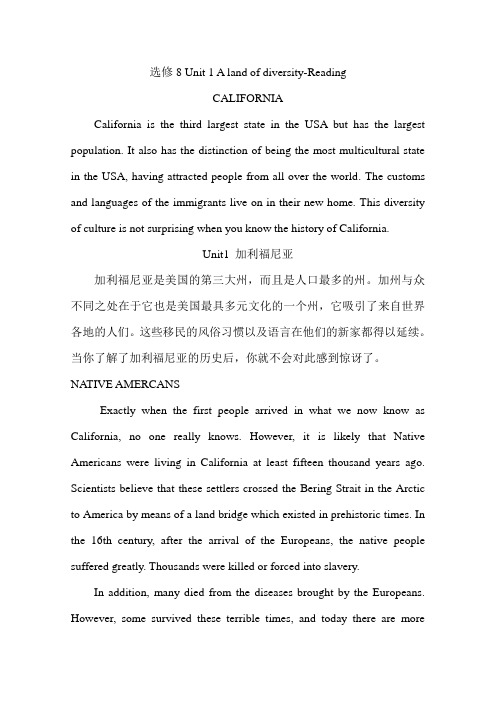
选修8 Unit 1 A land of diversity-ReadingCALIFORNIACalifornia is the third largest state in the USA but has the largest population. It also has the distinction of being the most multicultural state in the USA, having attracted people from all over the world. The customs and languages of the immigrants live on in their new home. This diversity of culture is not surprising when you know the history of California.Unit1 加利福尼亚加利福尼亚是美国的第三大州,而且是人口最多的州。
加州与众不同之处在于它也是美国最具多元文化的一个州,它吸引了来自世界各地的人们。
这些移民的风俗习惯以及语言在他们的新家都得以延续。
当你了解了加利福尼亚的历史后,你就不会对此感到惊讶了。
NATIVE AMERCANSExactly when the first people arrived in what we now know as California, no one really knows. However, it is likely that Native Americans were living in California at least fifteen thousand years ago. Scientists believe that these settlers crossed the Bering Strait in the Arctic to America by means of a land bridge which existed in prehistoric times. In the 16th century, after the arrival of the Europeans, the native people suffered greatly. Thousands were killed or forced into slavery.In addition, many died from the diseases brought by the Europeans. However, some survived these terrible times, and today there are moreNative Americans living in California than in any other state.美洲土著人最早的一批人具体是在什么时候来到我们现在所知道的加利福尼亚地区的,谁也说不清楚。
(完整版)人教版高中英语选修8课文及翻译

人教版高中英语选修8 课文及翻译选修8 Unit 1 A land of diversity-ReadingCALIFORNIACalifornia is the third largest state in the USA but has the largest population. It also has the distinction of being the most multicultural state in the USA, having attracted people from all over the world. The customs and languages of the immigrants live on in their new home. This diversity of culture is not surprising when you know the history of California.NATIVE AMERCANSExactly when the first people arrived in what we now know as California, no one really knows. However, it is likely that Native Americans were living in California at least fifteen thousand years ago. Scientists believe that these settlers crossed the Bering Strait in the Arctic to America by means of a land bridge which existed in prehistoric times. In the 16th century, after the arrival of the Europeans, the native people suffered greatly. Thousands were killed or forced into slavery. In addition, many died from the diseases brought by the Europeans. However, some survived these terrible times, and today there are more Native Americans living in California than in any other state.THE SPANISHIn the 18th century California was ruled by Spain. Spanish soldiers first arrived in South America in the early 16th century, when they fought against the native people and took their land. Two centuries later, the Spanish had settled in most parts of South America and along the northwest coast of what we now call the United States. Of the first Spanish to go to California, the majority were religious men, whose ministry was to teach the Catholic religion to the natives. In 1821, the people of Mexico gained their independence from Spain. California then became part of Mexico. In 1846 the United States declared war on Mexico, and after the war won by the USA, Mexico had to give California to the USA. However, there is still a strong Spanish influence in the state. That is why today over 40 of Californians speak Spanish as a first or second language.RUSSIANSIn the early 1800s, Russian hunters, who had originally gone to Alaska, began settling in California. Today there are about 25,000 Russian-Americans living in and around San Francisco.GOLD MINERSIn 1848, not long after the American-Mexican war, gold was discovered in California. The dream of becoming rich quickly attracted people from all over the world. The nearest, and therefore the first to arrive, were South Americans and people from the United States. Then adventurers from Europe and Asia soon followed. In fact, few achieved their dream of becoming rich. Some died or returned home, but most remained in California to make a life for themselves despite great hardship. They settled in the new towns or on farms. By the time California elected to become thethirty-first federal state of the USA in 1850, it was already a multicultural society.LATER A RRIVALSAlthough Chinese immigrants began to arrive during the Gold Rush Period, it was the building of the rail network from the west to the east coast that brought even larger numbers to California in the 1860s. Today, Chinese-Americans live in all parts of California, although a large percentage have chosen to stay in the "Chinatowns" of Los Angeles and San Francisco.Other immigrants such as Italians, mainly fishermen but also wine makers, arrived in California in the late 19th century. In 1911 immigrants from Denmark established a town of their own, which today still keeps up their Danish culture. By the 1920s the film industry was well established in Hollywood, California. The industry boom attracted Europeans including many Jewish people. Today California has the second largest Jewish population in the United States.Japanese farmers began arriving in California at the beginning of the 20th century, and since the 1980s a lot more have settled there. People from Africa have been living in California since the 1800s, when they moved north from Mexico. However, even more arrived between 1942 and 1945 to work in the ship and aircraft industries. MOST RECENT ARRIVALSIn more recent decades, California has become home to more people from Asia, including Koreans, Cambodians, Vietnamese and Laotians. Since its beginning in the 1970s, the computer industry has attracted Indians and Pakistanis to California. THE FUTUREPeople from different parts of the world, attracted by the climate and the lifestyle, still immigrate to California. It is believed that before long the mix of nationalities will be so great that there will be no distinct major racial or cultural groups, but simply a mixture of many races and cultures.GEORGE’S DIARY 12TH—14TH JUNEMonday 12th, JuneArrived early this morning by bus. Went straight to hotel to drop my luggage, shower and shave. Then went exploring. First thing was a ride on a cable car. From top of the hill got a spectacular view of San Francisco Bay and the city. Built in 1873, the cable car system was invented by Andrew Hallidie, who wanted to find a better form of transport than horse-drawn trams. Apparently he'd been shocked when he saw a terrible accident in which a tram's brakes failed, the conductor could not control the situation and the tram slipped down the hill dragging the horses with it. Had a late lunch at Fisherman's What. This is the district where Italian fishermen first came to San Francisco in the late 19th century and began the fishing industry. Now it's a tourist area with lots of shops, sea food restaurants and bakeries. It's also the place to catch the ferry to Angel Island and other places in the Bay.Did so much exploring at Fisherman's What. Am exhausted and don't feel like doing anything else. Early bed tonight!Tuesday 13th, JuneTeamed up with a couple from my hotel (Peter and Terri) and hired a car. Spent all day driving around the city. There's a fascinating drive marked out for tourists. It has blue and white signs with seagulls on them to show the way to go. It's a 79km round-trip that takes in all the famous tourist spots. Stopped many times to admire the view of the city from different angles and take photographs. Now have a really good idea of what the city's like.In evening, went to Chinatown with Peter and Terri. Chinese immigrants settled in this area in the 1850s. The fronts of the buildings are decorated to look like old buildings in southern China. Saw some interesting temples here, a number of markets and a great many restaurants. Also art galleries and a museum containing documents, photographs and all sorts of objects about the history of Chinese immigration, but it is closed in the evening. Will go back during the day. Had a delicious meal and then walked down the hill to our hotel.Wednesday 14th, JuneIn morning, took ferry to Angel Island from the port in San Francisco Bay. On the way had a good view of the Golden Gate Bridge. From 1882 to 1940 Angel Island was a famous immigration station where many Chinese people applied for right to live in USA. The cells in the station were very small, cold and damp; some did not even have light but the immigrants had nowhere else to go. Their miserable stay seemed to be punishment rather than justice and freedom to them. They wrote poems on the walls about their loneliness and mourned their former life in China. In 1940 the civil authorities reformed the system so that many more Chinese people were able to grasp the opportunity of settling in the USA. Made me very thoughtful and thankful for my life today.选修8 Unit 2 Cloning-ReadingCLONING: WHERE IS IT LEADING US?Cloning has always been with us and is here to stay. It is a way of making an exact copy of another animal or plant. It happens in plants when gardeners take cuttings from growing plants to make new ones. It also happens in animals when twins identical in sex and appearance are produced from the same original egg. The fact is that these are both examples of natural clones.Cloning has two major uses. Firstly, gardeners use it all the time to produce commercial quantities of plants. Secondly, it is valuable for research on new plant species and for medical research on animals. Cloning plants is straightforward while cloning animals is very complicated. It is a difficult task to undertake. Many attempts to clone mammals failed. But at last the determination and patience of the scientists paid off in 1996 with a breakthrough - the cloning of Dolly the sheep.The procedure works like this:On the one hand, the whole scientific world followed the progress of the first successful clone, Dolly the sheep. The fact that she seemed to develop normally was very encouraging. Then came the disturbing news that Dolly had become seriously ill. Cloning scientists were cast down to find that Dolly's illnesses were more appropriate to a much older animal. Altogether Dolly lived six and a half years, half the length of the life of the original sheep. Sadly the same arbitrary fate affected other species, such as cloned mice. The questions that concerned all scientists were: "Would this be a major difficulty for all cloned animals? Would it happen forever? Could it be solved if corrections were made in their research procedure?"On the other hand, Dolly's appearance raised a storm of objections and had a great impact on the media and public imagination. It became controversial. It suddenly opened everybody's eyes to the possibility of using cloning to cure serious illnesses and even to produce human beings.Although at present human egg cells and embryos needed for cloning research are difficult to obtain, newspapers wrote of evil leaders hoping to clone themselves to attain their ambitions. Religious leaders also raised moral questions. Governments became nervous and more conservative. Some began to reform their legal systems and forbade research into human cloning, but other countries like China and the UK, continued to accumulate evidence of the abundant medical aid that cloning could provide. However, scientists still wonder whether cloning will help or harm us and where it is leading us.克隆一直在我们左右并且已经被大多数人接受。
人教版高中英语 选修8 各单元课文原文
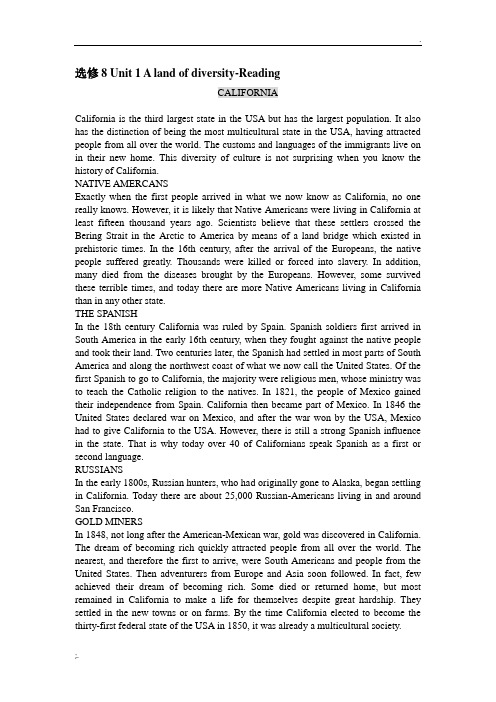
选修8 Unit 1 A land of diversity-ReadingCALIFORNIACalifornia is the third largest state in the USA but has the largest population. It also has the distinction of being the most multicultural state in the USA, having attracted people from all over the world. The customs and languages of the immigrants live on in their new home. This diversity of culture is not surprising when you know the history of California.NATIVE AMERCANSExactly when the first people arrived in what we now know as California, no one really knows. However, it is likely that Native Americans were living in California at least fifteen thousand years ago. Scientists believe that these settlers crossed the Bering Strait in the Arctic to America by means of a land bridge which existed in prehistoric times. In the 16th century, after the arrival of the Europeans, the native people suffered greatly. Thousands were killed or forced into slavery. In addition, many died from the diseases brought by the Europeans. However, some survived these terrible times, and today there are more Native Americans living in California than in any other state.THE SPANISHIn the 18th century California was ruled by Spain. Spanish soldiers first arrived in South America in the early 16th century, when they fought against the native people and took their land. Two centuries later, the Spanish had settled in most parts of South America and along the northwest coast of what we now call the United States. Of the first Spanish to go to California, the majority were religious men, whose ministry was to teach the Catholic religion to the natives. In 1821, the people of Mexico gained their independence from Spain. California then became part of Mexico. In 1846 the United States declared war on Mexico, and after the war won by the USA, Mexico had to give California to the USA. However, there is still a strong Spanish influence in the state. That is why today over 40 of Californians speak Spanish as a first or second language.RUSSIANSIn the early 1800s, Russian hunters, who had originally gone to Alaska, began settling in California. Today there are about 25,000 Russian-Americans living in and around San Francisco.GOLD MINERSIn 1848, not long after the American-Mexican war, gold was discovered in California. The dream of becoming rich quickly attracted people from all over the world. The nearest, and therefore the first to arrive, were South Americans and people from the United States. Then adventurers from Europe and Asia soon followed. In fact, few achieved their dream of becoming rich. Some died or returned home, but most remained in California to make a life for themselves despite great hardship. They settled in the new towns or on farms. By the time California elected to become the thirty-first federal state of the USA in 1850, it was already a multicultural society.LATER A RRIV ALSAlthough Chinese immigrants began to arrive during the Gold Rush Period, it was the building ofthe rail network from the west to the east coast that brought even larger numbers to California in the 1860s. Today, Chinese-Americans live in all parts of California, although a large percentage have chosen to stay in the "Chinatowns" of Los Angeles and San Francisco.Other immigrants such as Italians, mainly fishermen but also wine makers, arrived in California in the late 19th century. In 1911 immigrants from Denmark established a town of their own, which today still keeps up their Danish culture. By the 1920s the film industry was well established in Hollywood, California. The industry boom attracted Europeans including many Jewish people. Today California has the second largest Jewish population in the United States.Japanese farmers began arriving in California at the beginning of the 20th century, and since the 1980s a lot more have settled there. People from Africa have been living in California since the 1800s, when they moved north from Mexico. However, even more arrived between 1942 and 1945 to work in the ship and aircraft industries. MOST RECENT ARRIV ALSIn more recent decades, California has become home to more people from Asia, including Koreans, Cambodians, Vietnamese and Laotians. Since its beginning in the 1970s, the computer industry has attracted Indians and Pakistanis to California.THE FUTUREPeople from different parts of the world, attracted by the climate and the lifestyle, still immigrate to California. It is believed that before long the mix of nationalities will be so great that there will be no distinct major racial or cultural groups, but simply a mixture of many races and cultures.GEORGE’S DIARY 12TH—14TH JUNEMonday 12th, JuneArrived early this morning by bus. Went straight to hotel to drop my luggage, shower and shave. Then went exploring. First thing was a ride on a cable car. From top of the hill got a spectacular view of San Francisco Bay and the city. Built in 1873, the cable car system was invented by Andrew Hallidie, who wanted to find a better form of transport than horse-drawn trams. Apparently he'd been shocked when he saw a terrible accident in which a tram's brakes failed, the conductor could not control the situation and the tram slipped down the hill dragging the horses with it.Had a late lunch at Fisherman's What. This is the district where Italian fishermen first came to San Francisco in the late 19th century and began the fishing industry. Now it's a tourist area with lots of shops, sea food restaurants and bakeries. It's also the place to catch the ferry to Angel Island and other places in the Bay.Did so much exploring at Fisherman's What. Am exhausted and don't feel like doing anything else. Early bed tonight!Tuesday 13th, JuneTeamed up with a couple from my hotel (Peter and Terri) and hired a car. Spent all day driving around the city. There's a fascinating drive marked out for tourists. It has blue and white signs with seagulls on them to show the way to go. It's a 79km round-trip that takes in all the famous tourist spots. Stopped many times to admire the view of the city from different angles and take photographs. Now have a really good idea of what the city's like.In evening, went to Chinatown with Peter and Terri. Chinese immigrants settled in this area in the 1850s. The fronts of the buildings are decorated to look like old buildings in southern China. Saw some interesting temples here, a number of markets and a great many restaurants. Also art galleries and a museum containing documents, photographs and all sorts of objects about the history of Chinese immigration, but it is closed in the evening. Will go back during the day. Had a delicious meal and then walked down the hill to our hotel.Wednesday 14th, JuneIn morning, took ferry to Angel Island from the port in San Francisco Bay. On the way had a good view of the Golden Gate Bridge. From 1882 to 1940 Angel Island was a famous immigration station where many Chinese people applied for right to live in USA. The cells in the station were very small, cold and damp; some did not even have light but the immigrants had nowhere else to go. Their miserable stay seemed to be punishment rather than justice and freedom to them. They wrote poems on the walls about their loneliness and mourned their former life in China. In 1940 the civil authorities reformed the system so that many more Chinese people were able to grasp the opportunity of settling in the USA. Made me very thoughtful and thankful for my life today.选修8 Unit 2 Cloning-ReadingCLONING: WHERE IS IT LEADING US?Cloning has always been with us and is here to stay. It is a way of making an exact copy of another animal or plant. It happens in plants when gardeners take cuttings from growing plants to make new ones. It also happens in animals when twins identical in sex and appearance are produced from the same original egg. The fact is that these are both examples of natural clones.Cloning has two major uses. Firstly, gardeners use it all the time to produce commercial quantities of plants. Secondly, it is valuable for research on new plant species and for medical research on animals. Cloning plants is straightforward while cloning animals is very complicated. It is a difficult task to undertake. Many attempts to clone mammals failed. But at last the determination and patience of the scientists paid off in 1996 with a breakthrough - the cloning of Dolly the sheep. The procedure works like this:On the one hand, the whole scientific world followed the progress of the first successful clone, Dolly the sheep. The fact that she seemed to develop normally was very encouraging. Then came the disturbing news that Dolly had become seriously ill. Cloning scientists were cast down to find that Dolly's illnesses were more appropriate to a much older animal. Altogether Dolly lived six and a half years, half the length of the life of the original sheep. Sadly the same arbitrary fate affected other species, such as cloned mice. The questions that concerned all scientists were: "Would this be a major difficulty for all cloned animals? Would it happen forever? Could it be solved if corrections were made in their research procedure?"On the other hand, Dolly's appearance raised a storm of objections and had a great impact on the media and public imagination. It became controversial. It suddenly opened everybody's eyes to the possibility of using cloning to cure serious illnesses and even to produce human beings.Although at present human egg cells and embryos needed for cloning research are difficult to obtain, newspapers wrote of evil leaders hoping to clone themselves to attain their ambitions. Religious leaders also raised moral questions. Governments became nervous and more conservative. Some began to reform their legal systems and forbade research into human cloning, but other countries like China and the UK, continued to accumulate evidence of the abundant medical aid that cloning could provide. However, scientists still wonder whether cloning will help or harm us and where it is leading us.THE RETURN OF THE DINOSAURS?The possibility of cloning fierce and extinct wild animals has always excited film makers. And they are not the only ones! The popularity of films such as Jurassic Park, in which a scientist clones several kinds of extinct dinosaurs, proves how the idea struck a mixture of fear and excitement into people's hearts. But in fact we are a long way from being able to clone extinct animals. Scientists are still experimenting with cloning mammals. This is because the cloning of mammals is still a new science and its story only began seriously in the 1950s as this list shows:1950s cloning of frogs 1996 first clone of a mammal: Dolly the sheep1970s research using the embryos of mice 2000 cow gave birth to a bison1979 work on embryos of sheep and mice 2001 China's first cloned twin calves1981 first experimental clones of mice 2002 first cloned cats1983 first experimental clones of cows 2005 first cloned dog…From time to time people suggest that extinct animals like dinosaurs, can possibly be brought back to life through cloning. Unfortunately, with what we know now, this is either impossible or unsuitable. There are many reasons.◎The initial requirement is that you need perfect DNA (which gives information for how cellsare to grow).◎All efforts of cloning an animal will be in vain if there is not enough diversity in the group to overcome illnesses. Diversity in a group meanshaving animals with their genes arranged in different ways. The advantage is that if there is a new illness some of these animals may die,but others will survive and pass on the ability to resist that disease to the next generation. The great drawback to cloning a group ofanimals is that they would all have the same arrangement of genes and so might die of the same illness. Then none of them would be left tocontinue the species.◎It would be unfair to clone any extinct animals if they were to live in a zoo. A suitable habitat would be needed for them to lead a natural life.Based on what we know now, you cannot clone animals that have been extinct longer than 10,000 years. Actually, dinosaurs disappeared 65,000,000 years ago. So the chance of dinosaurs ever returning to the earth is merely a dream.选修8 Unit 3 Inventors and inventions-ReadingTHE PROBLEM OF THE SHRIKESWhen I called up my mother in the countryside on the telephone she was very upset. "There are some snakes in our courtyard," she told me. "Snakes come near the house now and then, and they seem to have made their home here, not far from the walnut tree. Can you get rid of them please?" I felt very proud. Here was a chance for .me to distinguish myself by inventing something merciful that would catch snakes but not harm them. I knew my parents would not like me to hurt these living creatures!The first thing I did was to see if there were any products that might help me, but there only seemed to be powders designed to kill snakes. A new approach was clearly needed. I set about researching the habits of snakes to find the easiest way to trap them. Luckily these reptiles are small and that made the solution easier.Prepared with some research findings, I decided on three possible approaches: firstly, removing their habitat; secondly, attracting them into a trap using male or female perfume or food; and thirdly cooling them so that they would become sleepy and could be easily caught. I decided to use the last one. I bought an ice-cream maker which was made of stainless steel. Between the outside and the inside walls of the bowl there is some jelly, which freezes when cooled. I put the bowl into the fridge and waited for 24 hours. At the same time I prepared some ice-cubes.The next morning I got up early before the sun was hot. I placed the frozen bowl over the snakes' habitat and the ice-cubes on top of the bowl to keep it cool. Finally I covered the whole thing with a large bucket. Then I waited. After two hours I removed the bucket and the bowl. The snakes were less active but they were still too fast for me. They abruptly disappeared into a convenient hole in the wall. So I had to adjust my plan.For the second attempt I froze the bowl and the ice-cubes again but placed them over the snakes' habitat in the evening, as the temperature was starting to cool. Then as before, I covered the bowl with the bucket and left everything overnight. Early the next morning I returned to see the result. This time with great caution I bent down to examine the snakes and I found them very sleepy. But once picked up, they tried to bite me. As they were poisonous snakes, I clearly needed to improve my design again.My third attempt repeated the second procedure. The next morning I carried in my hand a small net used for catching fish. This was in the expectation that the snakes would bite again. But monitored carefully, the snakes proved to be no trouble and all went according to plan. I collected the passive snakes and the next day we merrily released them all back into the wild.Pressed by my friends and relations, I decided to seize the opportunity to get recognition formy successful idea by sending my invention to the patent office. Only after you havehad thatrecognition can you say that you are truly an inventor. The criteria are so strict that it is difficult to get new ideas accepted unless they are truly novel. In addition, no invention will get a patent if it is:◎a discovery◎a scientific idea or mathematical model◎literature or art◎a game or a business◎a computer programme◎a new animal or plant varietyNor will you receive a patent until a search has been made to find out that your product reallyis different from everyone else's. There are a large number of patent examiners, too, whose only job is to examine whether your claim is valid or not. If it passes all the tests, your application for a patent will be published 18 months from the date you apply. So I have filled in the form and filed my patent application with the Patent Office. Now it's a matter of waiting and hoping. You'll know if I succeed by the size of my bank balance! Wish me luck!ALEXANDER GRAHAM BELLAlexander Graham Bell was born in 1847 in Scotland, but when he was young his family moved to Boston, USA. His mother was almost entirely deaf, so Alexander became interested in helping deaf people communicate and in deaf education. This interest led him to invent the microphone. He found that by pressing his lips against his mother's forehead, he could make his mother understand what he was saying.He believed that one should always be curious and his most famous saying was:"Leave the beaten track occasionally and dive into the woods. Every time you do you will be certain to find something that you have never seen before. Follow it up, explore all around it, and before you know it, you will have something worth thinking about to occupy your mind. All really big discoveries are the result of thought."It was this exploring around problems and his dynamic spirit that led to his most famous invention - the telephone in 1876. Bell never set out to invent the telephone and what he was trying to design was a multiple telegraph. This original telegraphsent a message over distances using Morse code (a series of dots tapped out along a wire in a particular order). But only one message could go at a time. Bell wanted to improve it so that it could send several messages at the same time. He designed a machine that would separate different sound waves and allow different conversations to be held at the same time. But he found the problem difficult to solve. One day as he was experimenting with one end of a straw joined to a deaf man's ear drum and the other to a piece of smoked glass, Bell noticed that when he spoke into the ear, the straw drew sound waves on the glass. Suddenly he had a flash of inspiration. If sound waves could be reproduced in a moving electrical current, they could be sent along a wire. In searching to improve the telegraph,Bell had invented the first telephone!Bell was fully aware of the importance of his invention and wrote to his father:"The day is coming when telegraph wires will be laid on to houses just like water or gas – and friends will talk to each other without leaving home."The patent was given in 1876, but it was not until five days later that Bell sent his first telephone message to his assistant Watson. The words have now become famous:"Mr Watson - come here - I want to see you."Alexander Graham Bell was not a man to rest and he interested himself in many other areas of invention. He experimented with helicopter designs and flying machines. While searching for a kite strong enough to carry a man into the air, Bell experimented putting triangles together and discovered the tetrahedron shape. Being very stable, it has proved invaluable in the design of bridges.Bell was an inventor all his life. He made his first invention at eleven and his last at seventy- five. Although he is most often associated with the invention of the telephone, he was indeed a continuing searcher after practical solutions to improve the quality of everybody's life.选修8 Unit 4 Pygmalion-ReadingPYGMALIONMAIN CHARACTERS:Eliza Doolittle (E): a poor flower girl who is ambitious to improve herself Professor Higgins (H): an expert in phonetics, convinced that the quality of a person's English decides his/her position in societyColonel Pickering (CP): an officer in the army and later a friend of Higgins' who sets him a taskAct One FATEFUL MEETINGS11 :15 pm in London, England in 1914 outside a theatre. It is pouring with rain and cab whistles are blowing in all directions. A man is hiding from the rainlistening to people's language and watching their reactions. While watching, he makes notes. Nearby a flower girl wearing dark garments and a woollen scarf is also sheltering from the rain. A gentleman (G) passes and hesitates for a moment.E: Come over’ere, cap’in, and buy me flowers off a poor girl.G: I'm sorry but I haven't any change.E: I can giv’ou change, cap’in.G: (surprised) For a pound? I'm afraid I've got nothing less.E: (hopefully) Oah! Oh, do buy a flower off me, Captain. Take this for three pence. (holds up some dead flowers)G: (uncomfortably) Now don't be troublesome, there's a good girl. (looks in his wallet and sounds more friendly) But, wait, here's some small change. Will that be of any use to you? It's raining heavily now, isn't it? (leaves)E: (disappointed at the outcome, but thinking it is better than nothing) Thank you, sir. (sees a man taking notes and feels worried) Hey! I ain’t done nothing wrong by speaking to that gentleman. I've a right to sell flowers, I have. I ain’t no thief. I'm an honest girl I am! (begins to cry)H: (kindly) There! There! Who's hurting you, you silly girl? What do you take me for? (gives her a handkerchief)E: I thought maybe you was a policeman in disguise.H: Do I look like a policeman?E: (still worried) Then why did 'ou take down my words for? How do I know whether 'ou took me down right? 'ou just show me what 'ou've wrote about me!H: Here you are. (hands over the paper covered in writing)E: What's that? That ain't proper writing. I can't read that. (pushes it back at him)H: I can. (reads imitating Eliza) "Come over' ere, cap'in, and buy me flowers off a poor girl." (in his own voice) There you are and you were bornin Lisson Grove if I'm not mistaken.E: (looking confused) What if I was? What's it to you?CP: (has been watching the girl and now speaks to Higgins) That's quite brilliant! How did you do that, may I ask?H: Simply phonetics studied and classified from people's own speech. That's my profession and also my hobby. You can place a man by just a few remarks. I can place any spoken conversation within six miles, and even within two streets in London sometimes.CP: Let me congratulate you! But is there an income to be made in that?H: Yes, indeed. Quite a good one. This is the age of the newly rich. People begin their working life in a poor neighbourhood of London with 80 pounds a year and end in a rich one with 100 thousand. But they betray themselves every time they open their mouths. Now once taught by me, she'd become an upper class lady ...CP: Is that so? Extraordinary!H: (rudely) Look at this girl with her terrible English: the English that will condemn her to the gutter to the end of her days. But, sir, (proudly) once educated to speak properly, that girl could pass herself off in three months as a duchess at an ambassador's garden party. Perhaps I could even find her a place as a lady's maid or ashop assistant, which requires better English.E: What's that you say? A shop assistant? Now that's sommat I want, that is!H: (ignores her) Can you believe that?CP: Of course! I study many Indian dialects myself and ...H: Do you indeed? Do you know Colonel Pickering?CP: Indeed I do, for that is me. Who are you?H: I'm Henry Higgins and I was going to India to meet you.CP: And I came to England to make your acquaintance!E: What about me? How'll you help me?H: Oh, take that. (carelessly throws a handful of money into her basket) We must have a celebration, my dear man. (leave together)E: (looking at the collected money in amazement) Well, I never. A whole pound! A fortune! That'll help me, indeed it will. Tomorrow I'll find you, Henry Higgins. Just you wait and see! All that talk of (imitates him) "authentic English" ... (in her own voice) I'll see whether you can get that for me ... (goes out)Act Two, Scene 1 MAKING THE BET It is 11am in Henry Higgins' house the next day. Henry Higgins and Colonel Pickering are sitting deep in conversation.H: Do you want to hear any more sounds?CP: No, thank you. I rather fancied myself because I can pronounce twenty-four distinct vowel sounds; but your one hundred and thirty beat me. I can't distinguish most of them.H: (laughing) Well, that comes with practice.There is a knock and Mrs Pearce (MP), the housekeeper, comes in with cookies, a teapot, some cream and two cups.MP: (hesitating) A young girl is asking to see you.H: A young girl! What does she want?MP: Well, she's quite a common kind of girl with dirty nails.I thought perhaps you wanted her to talk into your machines.H: Why? Has she got an interesting accent? We'll see.Show her in, Mrs Pearce. MP: (only half resigned to it) Very well, sir. (goes downstairs)H: This is a bit of luck. I'll show you how I make records on wax disks ...MP: (returning) This is the young girl, sir. (Eliza comes into the room shyly following Mrs Pearce. She is dirty and wearing a shabby dress. She curtsies to the two men.) H: (disappointed) Why! I've got this girl in my records. She's the one we saw theother day. She's no use at all. Take her away.CP: (gently to Eliza) What do you-want, young lady?E: (upset) I wanna be a lady in a flower shop 'stead o' selling flowers in the street. But they won't take me 'less I speak better. So here I am, ready to pay him. I'm not asking for any favours - and he treats me like dirt.H: How much?E: (happier) Now yer talking. A lady friend of mine gets French lessons for two shillings an hour from a real Frenchman. You wouldn't have the face to ask me for the same for teaching me as yer would for French. So I won't give yer more than a shilling.H: (ignoring Eliza and speaking to Pickering) If you think of how much money this girl has - why, it's the best offer I've had! (to Eliza) But if I teach you, I'll be worse than a father.CP: I say, Higgins. Do you remember what you said last night? I'll say you're the greatest teacher alive if you can pass her off as a lady. I'll be the referee for this little bet and pay for the lessons too ...E: (gratefully) Oh, yer real good, yer are. Thank you, Colonel.H: Oh, she is so deliciously low. (compromises) OK, I'll teach you. (to Mrs Pearce) But she'll need to be cleaned first. Take her away, Mrs Pearce. Wash her and burn her horrible clothes. We'll buy her new ones. What's your name, girl?E: I'm Eliza Doolittle and I'm clean. My clothes went to the laundry when I washed last week.MP: Well, Mr Higgins has a bathtub of his own and he has a bath every morning. If these two gentlemen teach you, you'll have to do the same. They won't like the smell of you otherwise.E: (sobbing) I can't. I dursn't. It ain't natural and it'd kill me. I've never had a bath in my life; not over my whole body, neither below my waist nor taking my vest off. I'd never have come if I'd known about this disgusting thing you want me to do ...H: Once more, take her away, Mrs Pearce, immediately. (Outside Eliza is still weeping with Mrs Pearce) You see the problem, Pickering. It'll be how to teach her grammar, not just pronunciation. She's in need of both.CP: And there's another problem, Higgins. What are we going to do once the experiment is over?H: (heartily) Throw her back.CP: But you cannot overlook that! She'll be changed and she has feelings too. We must be practical, mustn't we?H: Well, we'll deal with that later. First, we must plan the best way to teach her. CP: How about beginning with the alphabet. That's usually considered very effective ... (fades out as they go offstage together)。
高二年人教版选修8_Unit1_A_land_of_diversity_单词课件

√
means; way; method; approach
means 方法、手段、工具,单复数同形,多和 介词by 搭配。 way 方法,普通用语。可用于任何处理事物 的方式。多于介词in搭配。 method 方法,理论,指合乎逻辑或系统的方法。 多和介词with 搭配。
e.g.:teaching method 教学方法 approach +to(介词)
2. live on ① 继续存在;继续生存 ②靠……生活
① 继续存在;继续生存 After the earthquake, the old couple live on with their grandsons. 地震后,这对老夫妇和他们的孙子继续活下去。
②靠……生活 Small birds live mainly on insects. 小鸟主要靠食昆虫为生
percentage
n.百分比;百分率 a percentage of后接名词时,其后面谓语动词的单 复数要与所接名词相符合。 What percentage of the earth is covered by oceans? What percentage of the students were absent? the percentage of…某事物的百分比,作为数字, 谓语动词用单数形式。
nowhere放在句首,该句应使用倒装结构。 Nowhere is there a place for him to settle down.
类似的副词还有hardly scarcely, no sooner, seldom,
never, little等。
Nowhere else in such a small town, I think C a book as good as this one. _____ A. you get B. you can get C. can you get D. you will get
- 1、下载文档前请自行甄别文档内容的完整性,平台不提供额外的编辑、内容补充、找答案等附加服务。
- 2、"仅部分预览"的文档,不可在线预览部分如存在完整性等问题,可反馈申请退款(可完整预览的文档不适用该条件!)。
- 3、如文档侵犯您的权益,请联系客服反馈,我们会尽快为您处理(人工客服工作时间:9:00-18:30)。
选修8 Unit 1 单词及课文详解△California 加利福尼亚(州)△Californian 加利福尼亚(州)人△illustrate vt. 说明;阐明 illustration 实例插图图解Be illustrated with 有插图 - sth. 给书加插图阐明By way of -tion 作为说明 in -tion of 作为...例证distinct adj. 清晰的;明显的;明确的 distinctive 独特的有特色的distinction n. 差别;区分cn;卓著优秀un.Distinguish between and :distinguish A from B -ed 杰出的以...著名Make a distinction between andMake no distinction 没有区别: without distinction with distinction 优异地△immigrant n. (从外国移入的)移民live on 继续存在;继续生存 - by 以..为生 - through 活过度过...熬过Live up to 实践原则誓言等做到 - down 改过自新生活忘掉过错strait n. 海峡=straits△Bering 白令海峡Arctic adj. 北极的;北极区的the Arctic 北极means n. 手段;方法by means of… 用……办法;借助 By all means 一定务必 by no means 绝不By this means 通过这种方式:in this way/ with this method/ in this manner by some means or other 想尽办法△prehistoric adj. 史前的majority n. 大多数;大半 the - 做主语谓语动词单数各个成员可用复数The - of + 单数名词或pl. 谓语动词与名词保持一致In a - 占大多数 get a - 获得多数票 have a - 拥有多数Major minor minority -ity ...状态、性质ministry n. (政府的)部;(全体)牧师;牧师的职责神职任期 the - of Defense Catholic adj. 天主教的 n.天主教徒△Alaska n. 阿拉斯加(州)△San Francisco n. 圣弗朗西斯科(也称旧金山)△adventurer n. 冒险家make a life 习惯于新的生活方式、工作等△despite prep. 尽管;不管hardship n. 苦难;困苦elect vt. 选择;决定做某事;选举某人federal adj. 联邦制的;联邦政府的rail n. 铁路;扶手;(护栏的)横条percentage n. 百分比;百分率△Los Angeles n. 洛杉矶Italy n. 意大利Italian n. 意大利人;意大利语adj.意大利人的;意大利语的Denmark n. 丹麦(北欧国家)keep up 坚持;维持;沿袭(风俗、传统等)- away from 不接近- back 阻止抑制 -... From 阻止免受伤害 - off 远离 - out 使不入内- up with 跟上 -an eye on 注视 - hold of 抓住 - a record of记载 - in touch with△Hollywood n. 好莱坞;美国电影业boom n. (人口、贸易的)繁荣(运动音乐)突然风靡的时期深沉的响声V. 轰鸣激增处于经济迅速发展时期-er=baby -er 生育高峰期出生的人 - town 新兴都市aircraft n. 飞行器;航空器;飞机△Cambodian n. 柬埔寨人;柬埔寨语Korea n. 韩国;朝鲜Korean n. 韩国/朝鲜人;朝鲜/韩语 adj.韩国(人/语)的;朝鲜(人/语)的Pakistan n. 巴基斯坦Pakistani adj. 巴基斯坦(人)的 n.巴基斯坦人△immigrate vi. 移入(外国定居)immigration n. 移民;移居入境racial adj. 人种的;种族的crossing n. 横渡;横越;十字路口;人行横道vice n. & adj. 代理;副职nephew n. 侄子;外甥pole n. 地极;电极;磁极applicant n. 申请人customs n. 海关;关税;进口税socialist n. 社会主义者;社会党人 adj.社会主义者的socialism n. 社会主义occur vi. 发生;出现有计划或无计划It -s to sb. To do/ that... 某人想到 -rencecattle n. 牛(总称)△Hispanic n. (美)讲西班牙语的美国人indicate vt. 指出;指示;表明;暗示back to back 背靠背luggage n. 行李(<美>baggage)shave vt. & vi. (shaved; shaved, shaven) 刮;剃△cable n. 缆绳;绳索;电缆△cable car 缆车;(美)有轨缆车△Andrew Hallidie 安德鲁•海利迪tram n. (有轨)电车apparent adj. 显而易见的;显然的;表面上的apparently adv. 显然地;显而易见地It is - to sb. That... 在某人看来显然...brake n. 闸;刹车;制动器 Vi. & vt. 刹(车);用制动器减速conductor n. (公车)售票员;列车员;(乐队)指挥slip vi. 滑动;滑行;滑跤 n.滑动;滑倒小错误- off 迅速脱去衣服:- out of -on 迅速穿上 -out 被无意中说出- away 消失消亡 - up 犯错误疏忽△wharf n. 码头bakery n. 面包房;面包厂ferry n. 渡船;渡口 vt.摆渡;渡运△Angel Island 天使岛team up with 与……合作或一起工作hire vt. & n. 租用;雇用- sth. To ...租给 - ... From...向...租借租设备用hire 租房子:let/rent△fascinating adj. 迷人的;吸引人的mark out 划线;标出……界线选定表明- down 记下减价给低分 - off 划出界限 -up 标高价格 - with 以..为标记- for life 留下终生的伤痕seagull n. 海鸥take in 包括;吸收理解欺骗- apart 拆开 -away 拿走 - back 收回- to 喜欢习惯 - on承担呈现雇佣 - over 接管-up 占据继续 -up with 和交往angle n. 角;角度a great/good many 许多;很多Many/many a/an / a great/good many/ more than one/ a good/large number of +pl.Much/ a good/great deal of/ a large amount of /amounts of+unA lot of/lots of/ a quantity of/ quantities of/ plenty of/ a supply of/supplied of+pl./unAmounts of/ quantities of+un. 谓语动词用复数Many a(more than one)+单数谓语动词用单数apply for 申请;请示得到Apply 申请敷产生作用使努力- to do 申请做 - ..to..将...涂抹于- oneself to 专心从事 applicant application appliednowhere adv. 无处;到处都无△miserable adj. 痛苦的;悲惨的punishment n. 处罚;惩罚justice n. 公正;公平mourn vt. & vi. 哀悼;悼念;表示悲痛 -er哀悼者 -ful 忧伤的 -ing n, 哀悼civil adj. 公民的;国内的;民间的authority n. 权威;权力 (pl)当局;官方reform vt. & vi. 改革;革新 n.改革;改造;改良grasp vt. & n. 抓住;抓紧;掌握;领会△thoughtful adj. 关切的;体贴的;深思的thankful adj. 感激的;感谢的insert vt. 插入;嵌入 n. 插面广告挿入物 -ion 放入选修八Unit1 CALIFORNIA加利福尼亚California is the third largest state in the USA but has the largest population (grow/fall; large/small). 加州是美国第三大洲, 而且是人口最多的州。
It also has the distinction of (有与众不同之处)being the most multicultural(多元文化的,multi-多方面多方向 multicolored multimedia multiparty) state in the USA, having attracted people from all over the world. 加州与众不同之处在于它也是美国最具多元文化的一个州。
它吸引了来自世界各地的人们。
The customs and languages of the immigrants live on in their new home. 这些移民的风俗习惯以及语言在他们的新家都得以延续。
This diversity of culture is not surprising when you know the history of California.当你了解了加利福尼亚的历史,你就不会对其文化的多样性感到惊奇了。
NATIVE AMERCANS美洲土著人Exactly when the first people arrived in what we now know as California, no one really knows. 最早一批人具体是什么时候来到我们现在了解的加利福尼亚地区的, 谁也说不清楚。
